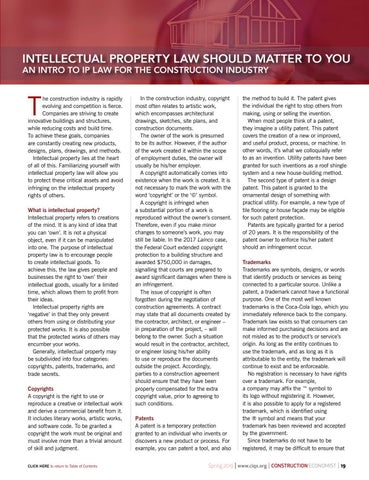INTELLECTUAL PROPERTY LAW SHOULD MATTER TO YOU AN INTRO TO IP LAW FOR THE CONSTRUCTION INDUSTRY
T
he construction industry is rapidly evolving and competition is fierce. Companies are striving to create innovative buildings and structures, while reducing costs and build time. To achieve these goals, companies are constantly creating new products, designs, plans, drawings, and methods. Intellectual property lies at the heart of all of this. Familiarizing yourself with intellectual property law will allow you to protect these critical assets and avoid infringing on the intellectual property rights of others.
What is intellectual property? Intellectual property refers to creations of the mind. It is any kind of idea that you can ‘own’. It is not a physical object, even if it can be manipulated into one. The purpose of intellectual property law is to encourage people to create intellectual goods. To achieve this, the law gives people and businesses the right to ‘own’ their intellectual goods, usually for a limited time, which allows them to profit from their ideas. Intellectual property rights are ‘negative’ in that they only prevent others from using or distributing your protected works. It is also possible that the protected works of others may encumber your works. Generally, intellectual property may be subdivided into four categories: copyrights, patents, trademarks, and trade secrets. Copyrights A copyright is the right to use or reproduce a creative or intellectual work and derive a commercial benefit from it. It includes literary works, artistic works, and software code. To be granted a copyright the work must be original and must involve more than a trivial amount of skill and judgment. CLICK HERE to return to Table of Contents
In the construction industry, copyright most often relates to artistic work, which encompasses architectural drawings, sketches, site plans, and construction documents. The owner of the work is presumed to be its author. However, if the author of the work created it within the scope of employment duties, the owner will usually be his/her employer. A copyright automatically comes into existence when the work is created. It is not necessary to mark the work with the word ‘copyright’ or the ‘©’ symbol. A copyright is infringed when a substantial portion of a work is reproduced without the owner’s consent. Therefore, even if you make minor changes to someone’s work, you may still be liable. In the 2017 Lainco case, the Federal Court extended copyright protection to a building structure and awarded $750,000 in damages, signalling that courts are prepared to award significant damages when there is an infringement. The issue of copyright is often forgotten during the negotiation of construction agreements. A contract may state that all documents created by the contractor, architect, or engineer – in preparation of the project, – will belong to the owner. Such a situation would result in the contractor, architect, or engineer losing his/her ability to use or reproduce the documents outside the project. Accordingly, parties to a construction agreement should ensure that they have been properly compensated for the extra copyright value, prior to agreeing to such conditions. Patents A patent is a temporary protection granted to an individual who invents or discovers a new product or process. For example, you can patent a tool, and also
the method to build it. The patent gives the individual the right to stop others from making, using or selling the invention. When most people think of a patent, they imagine a utility patent. This patent covers the creation of a new or improved, and useful product, process, or machine. In other words, it’s what we colloquially refer to as an invention. Utility patents have been granted for such inventions as a roof shingle system and a new house-building method. The second type of patent is a design patent. This patent is granted to the ornamental design of something with practical utility. For example, a new type of tile flooring or house façade may be eligible for such patent protection. Patents are typically granted for a period of 20 years. It is the responsibility of the patent owner to enforce his/her patent should an infringement occur. Trademarks Trademarks are symbols, designs, or words that identify products or services as being connected to a particular source. Unlike a patent, a trademark cannot have a functional purpose. One of the most well known trademarks is the Coca-Cola logo, which you immediately reference back to the company. Trademark law exists so that consumers can make informed purchasing decisions and are not misled as to the product’s or service’s origin. As long as the entity continues to use the trademark, and as long as it is attributable to the entity, the trademark will continue to exist and be enforceable. No registration is necessary to have rights over a trademark. For example, a company may affix the ™ symbol to its logo without registering it. However, it is also possible to apply for a registered trademark, which is identified using the ® symbol and means that your trademark has been reviewed and accepted by the government. Since trademarks do not have to be registered, it may be difficult to ensure that
Spring 2019 | www.ciqs.org | CONSTRUCTION ECONOMIST | 19
